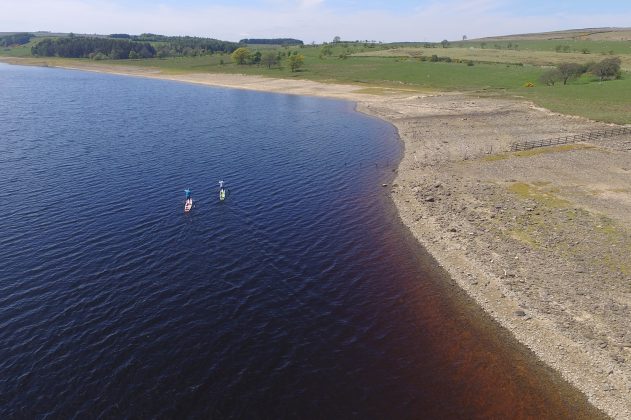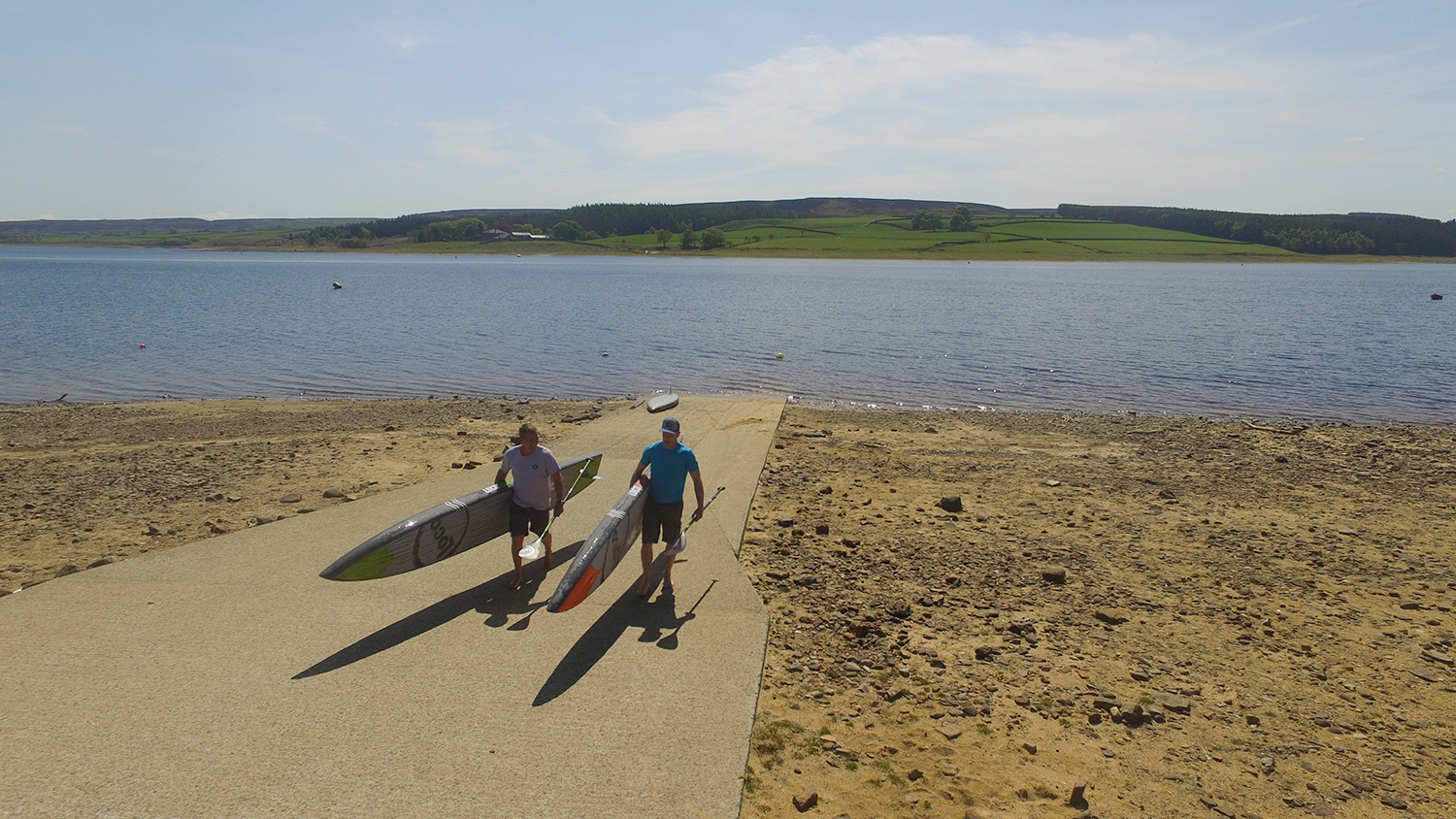PADDLE SCIENCE #15 –
SMART MUSCLE TRAINING.
Words – Kate Starling
Photos – matt@edgeofthemap.co.uk
Some athletes are able to sprint paddle faster and are able to develop bigger muscles more easily whilst some athletes will be able to paddle for longer and further without fatigue. This is largely based upon which muscle fibres are recruited in your body. If you’re thinking of creating a SUP training programme for the summer then understanding what types of fibres you have in your muscles will greatly influence how you will adapt to any training programme.
Types of Muscle Fibres
Within our bodies we have three different types of muscle fibres. Slow twitch or Type I fibres are identified by a slow contraction time and have a high resistance to fatigue. Functionally, slow twitch muscle fibres are used during aerobic activities which require low level force production. This includes most daily activities such as walking and maintaining posture. Fast twitch or Type II fibres are identified by a quick contraction time and have a low resistance to fatigue. These fibres can be further divided into fast twitch A (or Type IIA) and fast twitch B (or Type II B) fibres. Fast twitch A fibres have a moderate resistance to fatigue and are used for prolonged anaerobic activities with a relatively high force output. They could for example be used in a 400m SUP race. Meanwhile, fast twitch B fibres are very sensitive to fatigue and are used for short anaerobic, high force production activities, such as sprinting over a short distance.
During an isometric contraction where the muscle doesn’t change its length, both slow and fast twitch fibres produce the same level of force. However, as soon as you move, a dynamic contraction will lead to muscle shortening and lengthening. During dynamic contractions, fast twitch muscle fibres are capable of producing much more force and power when compared to slow twitch fibres.
Typically, endurance athletes have a greater proportion of slow twitch fibres whilst sprinters will have a greater proportion of fast twitch fibres. Research into identical twins has identified that muscle fibre composition is very much genetically determined. This means that genetically you’ll have either have a greater percentage of slow twitch fibres, making you better at endurance activities or you’ll have a greater percentage of fast twitch fibres making you better at shorter, faster activities.
What Muscle Fibres Do You Have?
The only way you can directly determine the proportion of slow and fast twitch muscle fibres you have in your body is to do a muscle biopsy. However, fortunately, a less painful and less invasive way exists to establish your muscle fibre composition. This method involves lifting the heaviest weight you can possibly lift. This known as the 1RM as the weight should be so heavy you’re only able to lift it once. Once this maximal weight is established, you then need to find a weight that is 80% of your 1RM and perform as many repetitions using this weight as possible. If you can only do less than seven repetitions then it’s likely that your muscles consist of more than 50% fast twitch fibres. If however, you can perform twelve or more repetitions then your muscles likely consist of more than 50% slow twitch fibres. If you’re able to perform between 7-12 repetitions then you probably have an equal proportion of both slow and fast twitch muscle fibres. Ultimately, knowing whether you have more slow and fast twitch fibres also comes down to how well you perform in sport. Your dominant muscle fibre group will normally become quite evident based on whether you perform better at either distance or sprint activities.
Training Programmes
If when you SUP you feel as if you can happily paddle long distances but can never quite acquire the speed you need for a sprint race a specific training programme can help. The same is true if you’re better at sprinting but are keen to improve your endurance. The structure and metabolic capacity of individual muscle fibres can adapt specifically to different types of training. Developing a good SUP training programme for either speed or endurance can therefore help to improve your chances of winning that next sprint or distance event. A fundamental element of training is this: irrespective of your workout intensity, slow twitch muscle fibres are always recruited first. If the intensity of your workout remains low, then these muscle fibres may be the only ones which are recruited for the duration of your workout session.
However, if you increase the intensity of your workout, such as performing SUP intervals, your slow twitch fibres will be recruited first, followed by your fast twitch A and fast twitch B fibres. Training for either endurance or speed therefore means that you need to target and recruit the right muscle fibres during your SUP sessions. This is intrinsic to improving performance.
It’s important to recognise that training fast twitch muscle fibres for endurance will never increase the number of slow twitch fibres you have. Similarly, if you train slow twitch muscle fibres for strength and power it will never increase the number of fast twitch fibres. There is also no conversion between your muscle fibres. Fast twitch cannot become slow twitch and vice versa. You are what you are and that’s the way you were born. However, with the right training, you can change the amount of area taken up by each fibre type within a muscle. In other words, specific training can result in selective hypertrophy of muscle fibres.
For example, an athlete may have a 50/50 mix of fast twitch and slow twitch fibres within a muscle. However, as fast twitch fibres normally have a larger cross-sectional area than slow twitch fibres, 65% of that muscle’s area may be fast twitch and 35% may be slow twitch. Following a strength or interval training program to improve muscular strength or speed, the number of fast and slow twitch fibres will remain the same (still 50/50), however the cross sectional area will change. This occurs because the slow twitch fibres will atrophy and become smaller whilst the fast twitch fibres will hypertrophy and become bigger. Depending on the level of training intensity you work at, the muscle may therefore change to a 75% fast twitch area and a 25% slow twitch area. This change will consequently lead to improved strength and speed but will reduce your endurance. Furthermore, since the mass of the fast twitch fibres are greater than that of the slow twitch fibres, you’ll gain mass as measured by the circumference of the muscle.
In contrast to this, if you train for muscular endurance, your fast twitch fibres will atrophy whilst your slow twitch fibres will hypertrophy. This will increase the cross sectional area of slow twitch muscle fibres. Therefore, the area of the muscle, which began at 65% fast twitch and 35% slow twitch prior to training, may change to 50% fast twitch and 50% slow twitch at the end of your training programme. Whilst this will increase the endurance capabilities of the muscle it will reduce muscular strength. As slow twitch fibres are lower in mass compared to fast twitch fibres, this will also result in an overall loss of muscle mass and a smaller muscle circumference.
“If you’re thinking of creating a SUP training programme for the summer then understanding what types of fibres you have in your muscles will greatly influence your response to training.”
Training for Speed and Strength
If you’ve set your sights on a sprint race or want to paddle more quickly, you need to focus on recruiting your fast twitch muscle fibres. Critically, a high level of training intensity is required to recruit your fast twitch B fibres. These fibres will not be recruited during low to moderate intensity exercise. However, when they are recruited they produce greater force and power than your slow twitch or fast twitch A fibres. The best way to target these fibres is to focus on high intensity interval training including speed and sprint work which involves periods of high energy explosive output with periods of active recovery.
Training for Speed on the Water:
A SUP interval training session would be as follows:
• Warm-up with a gentle SUP for ten minutes.
• Perform 30-second to 60-second sprints over a short distance.
• Return to a gentle SUP for active recovery for 30 or 60 seconds.
• Repeat your SUP sprint and continue that cycle.
• Aim to use a work:rest ratio of 1:1 or 2:1.
Importantly, if you have a higher proportion of fast twitch fibres, you’ll likely fatigue sooner and will need longer rest periods in between intervals. Another option is to perform fewer intervals at a faster speed. As interval training is physically demanding, your training sessions should be short in duration with just one or two sessions each week.
Training for Strength off the Water:
To help you achieve better sprint gains, working on muscular strength is also important. When you’re not on the water, compliment your SUP training programme with some weight work in the gym. Remember you’re looking to recruit your fast twitch B fibres so this requires heavy weights with a small number of repetitions so that your workout intensity is high.
• Typically, muscular strength will develop when a maximum of 8 repetitions or less can be performed. This is known as 8RM or the maximum amount of weight that can be lifted eight times.
• If you want to increase the neuro- muscular component of maximum strength, you should aim to lift at least 95% of your 1RM with to 3 repetitions.
• If you want to increase your maximum strength by stimulating muscle hypertrophy, you need to lift at least 80% of 1RM, 5 to 8 times or until failure.
• Meanwhile, if the aim of training is to increase muscle size or hypertrophy with moderate gains in strength, then 6 to 12 repetitions should be used.
Training for Endurance
To develop endurance, you need to target your slow twitch muscle fibres. This means focussing on increasing your weekly SUP mileage and SUP-ing for longer at a steady pace.
• Typically, your training intensity should be less than 70% VO2max, or equivalent to about 80% of your maximum heart rate.
• A good gauge is to use the ‘talk’ test whereby you’re able to hold a conversation as you paddle without being too breathless.
• You should aim to paddle distances which take at least thirty minutes to two hours in length.
• If you’re training for a distance race, then you should also aim to paddle close to your race distance.
Outside of your SUP sessions you can also use gym weights to increase your muscular endurance. Focus on low-intensity exercises working at less than 67% of your 1RM. You should also aim to perform a high number of over twelve repetitions for two to three sets.
SUP Training Limitations
Ultimately, the proportion of slow and fast twitch muscle fibres you have will play a major role in the amount of weight you can lift, the number of repetitions you can complete and the level to which you’re able to increase your muscular strength, power or endurance for SUP. For example, an athlete with a greater proportion of fast twitch fibres won’t be able to perform as many repetitions at a given weight as an athlete with a greater proportion of slow twitch fibres and therefore won’t be able to develop as high a level of muscular endurance. Meanwhile, in comparison to an athlete with a greater percentage of fast twitch fibres, an athlete with a higher number of slow twitch fibres won’t be able to lift as heavy a weight, will be unable to perform intervals as fast and will never be as strong or as powerful. This means that despite working hard and following a good training programme, the proportion of fast and slow twitch muscle fibres in your body has the potential to either enhance or limit your sports performance.
Notably, amongst sprinters and distance athletes, the proportion of fast and slow twitch muscle fibres will also differ. This means that if you’re following a SUP training programme you have to bear in mind that as an individual, you’re genetically different to everyone else. Whilst your training buddy might be able to SUP sprint 200m ten times, you may only be able to sprint the same distance eight times before you fatigue. The same goes for your endurance ability when SUP-ing over a long distance.
If you train smartly, everyone has the ability to improve either their SUP speed and strength or their endurance. However, to gain maximum results, the best plan is to train according to your genetic predisposition. If you’re naturally better at short distance work or sprinting then aim to target your fast twitch fibres with high intensity training. If you’re naturally better at endurance activities then aim to target your slow twitch fibres with lower intensity distance training. Aim to choose races and events that favour your genetic predisposition so that you can be specific with your training plan. If you train and recruit the right muscle fibres that next win might well be in sight this summer. SUP INTERNATIONAL
Kate is a physiotherapist and standup paddler. Reach her at www.newquayphysio.co.uk




